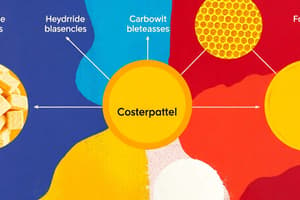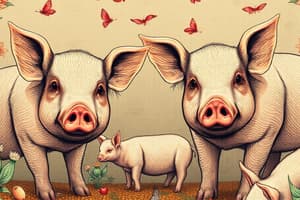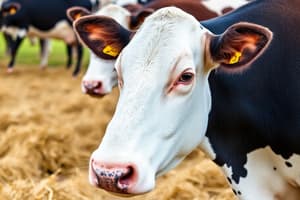Podcast
Questions and Answers
What is a likely consequence of colic related to pH changes in the body?
What is a likely consequence of colic related to pH changes in the body?
- Laminitis (correct)
- Absence of gastrointestinal symptoms
- Higher energy retention
- Increased appetite
Which type of energy is primarily used for muscle usage?
Which type of energy is primarily used for muscle usage?
- Digestible energy
- Metabolizable energy (correct)
- Net energy
- Gross energy
What is the main purpose of coprophagia in some animals?
What is the main purpose of coprophagia in some animals?
- To enhance digestive efficiency
- To regain microbial nutrients and vitamins (correct)
- To detoxify harmful substances
- To increase body weight
What is the main cause of colic due to gastrointestinal upset?
What is the main cause of colic due to gastrointestinal upset?
Which component is NOT part of the dry matter in nutrition?
Which component is NOT part of the dry matter in nutrition?
Flashcards
Cecum function
Cecum function
The cecum is a part of the digestive system that produces lactic acid and releases volatile fatty acids, important for digestion in some animals. It also has a specific pH to digest indigestible fiber.
Coprophagy
Coprophagy
Eating one's own feces to recover nutrients and vitamins from microorganisms in the digestive tract.
Colic symptoms
Colic symptoms
Colic is a gastrointestinal upset characterized by symptoms such as heat, pawing, rolling, sweating, difficulty defecating, and groaning.
Nutrient Requirements
Nutrient Requirements
Signup and view all the flashcards
Metabolizable Energy (ME)
Metabolizable Energy (ME)
Signup and view all the flashcards
Study Notes
Homeostasis: Balanced Energy Needs/Neutral Conditions
- Cecum:
- Has natural pH (cellulose & hemicellulose).
- 1.2 meters long, holding 25-30 liters (like a paint bucket).
- Produces lactic acid.
- Releases volatile fatty acids.
- Coprophagy:
- Eating own feces to regain microbial nutrients and vitamins.
- Human feeding frequency changes.
- Nutrient Requirements:
- Use NRC (National Research Council) to formulate diets for animals.
- Kilo = 1000
- Mega = 1,000,000
- Adjusting energy based on:
- Amount of feed.
- Energy density of the food.
- Dry matter, fat, protein, carbs
- Energy calculations:
- Gross energy: the total energy consumed in the feed.
- Digestible energy: energy absorbed/retained by the body.
- Fecal energy: energy lost in the feces.
- Urine energy: energy lost in the urine.
- Metabolizable energy (ME): usable energy for the cells (epithelial cells)
- Energy for living and muscle usage.
- Net energy (NE): energy remaining after all losses (energy = maintenance).
Colic (Gastrointestinal Upset)
- Symptoms:
- Pawing
- Rolling
- Sweating
- Failed to defecate
- Groaning
- Causes:
- Idiopathic (unknown cause)
- Impaction (sand)
- Gas/fermentation
- Strangulation (twisted gut).
- Hooves:
- Sensitive to the body's pH.
- Inflammation can lead to colic.
- Acidic pH associated with inflammation and colic.
- Hooves:
- Lamina (tissue below the hoof)
- Laminitis = "founder"
Studying That Suits You
Use AI to generate personalized quizzes and flashcards to suit your learning preferences.




